Amit and Prem are very good cricketers and also represented their school team at district and even state levels. One day, after their match, they measured the height of the wickets and found it to be 28 inches. They marked a point . P on the ground as shown in the figure below:
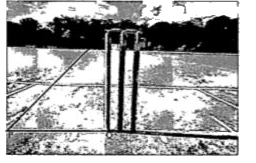 ,
,
If cot P=34 the length of PQ is:
3 in
7 in
21 in
35 in
The correct Answer is:C
Step by step video & image solution for Amit and Prem are very good cricketers and also represented their school team at district and even state levels. One day, after their match, they measured the height of the wickets and found it to be 28 inches. They marked a point . P on the ground as shown in the figure below: , If cot P = 3/4 the length of PQ is: by Maths experts to help you in doubts & scoring excellent marks in Class 10 exams.
Updated on:21/07/2023Topper's Solved these Questions
- SAMPLE PAPER -5Book:EDUCART PUBLICATIONChapter:SAMPLE PAPER -5Exercise:SECTION-C
Explore 11 Videos
- SAMPLE PAPER -5Book:EDUCART PUBLICATIONChapter:SAMPLE PAPER -5Exercise:SECTION-C
Explore 11 Videos
- SAMPLE PAPER - 3Book:EDUCART PUBLICATIONChapter:SAMPLE PAPER - 3Exercise:SECTION-C
Explore 10 Videos
- SAMPLE PAPER -6 Book:EDUCART PUBLICATIONChapter:SAMPLE PAPER -6 Exercise:Part - B (Section - V)
Explore 6 Videos
Similar Questions
Read the passages given below and answer the questions that follow them:
1. Nowadays, Mother's Day celebrations are held throughout the world though they may not fall at the same time. The way of celebrating may also differ but the purpose is the same. It is to honour the mother and to feel and cherish the beautiful bonds we share with her. It would be interesting to find out how the idea of Mother's Day first took root and who was its originator.
2. The first celebrations were held in spring in ancient Greece, by paying tribute to Rhea, the ‘Mother of Gods’. During the 17th century, England honoured mothers by celebrating 'Mothering Sunday' on the fourth Sunday of Lent. In the United States, Julia Ward Home suggested the idea in 1872 and perceived Mother's Day as being dedicated to peace.
3. But it was Anna Jarvis of Philadelphia who brought about the official observance of Mother's Day. She wanted this day to be a holiday and launched a campaign for it. This she did in memory of her mother who died in 1905 and who had, in the late 19th century, tried to establish 'Mother's Friendship Days' as a way to heal the scars of Civil War.
4. In 1907, Jarvis held a ceremony in Grafton, West Virginia, to honour her mother. The proceedings touched her so greatly that she began a massive campaign to adopt a formal holiday for honouring mothers and in 1910, West Virginia became the first state to recognise Mother's Day. A year later, nearly every state officially marked the day. In 1914, President Woodrow Wilson officially proclaimed Mother's Day as a national holiday to be held on the second Sunday of May.
5. But all her efforts to make Mother's Day one of sentiment and love proved futile when she found that the holiday had been commercialised. Her accomplishment then turned bitter for her. She fought against the commercialisation of this day. She filed a lawsuit to stop a 1923 Mother's Day. She was even arrested for disturbing the peace at a War Mother's Convention where women sold white carnations. White carnation was her symbol for mothers, helping her to raise money. She never intended this day to be one for profit making and that was exactly what it had become.
6. Jarvis was never a mother herself. She spent her maternal fortune trying to stop the commercialisation of the holiday she founded. Today, countries like Denmark, Finland, Italy, Turkey, Australia and Belgium also celebrate Mother's Day on the same day as the United States.
On the basis of your reading of the passage, answer the question
Describe the first celebrations of Mother's Day in different parts of the world.
View SolutionRead the passages given below and answer the questions that follow them:
1. Nowadays, Mother's Day celebrations are held throughout the world though they may not fall at the same time. The way of celebrating may also differ but the purpose is the same. It is to honour the mother and to feel and cherish the beautiful bonds we share with her. It would be interesting to find out how the idea of Mother's Day first took root and who was its originator.
2. The first celebrations were held in spring in ancient Greece, by paying tribute to Rhea, the ‘Mother of Gods’. During the 17th century, England honoured mothers by celebrating 'Mothering Sunday' on the fourth Sunday of Lent. In the United States, Julia Ward Home suggested the idea in 1872 and perceived Mother's Day as being dedicated to peace.
3. But it was Anna Jarvis of Philadelphia who brought about the official observance of Mother's Day. She wanted this day to be a holiday and launched a campaign for it. This she did in memory of her mother who died in 1905 and who had, in the late 19th century, tried to establish 'Mother's Friendship Days' as a way to heal the scars of Civil War.
4. In 1907, Jarvis held a ceremony in Grafton, West Virginia, to honour her mother. The proceedings touched her so greatly that she began a massive campaign to adopt a formal holiday for honouring mothers and in 1910, West Virginia became the first state to recognise Mother's Day. A year later, nearly every state officially marked the day. In 1914, President Woodrow Wilson officially proclaimed Mother's Day as a national holiday to be held on the second Sunday of May.
5. But all her efforts to make Mother's Day one of sentiment and love proved futile when she found that the holiday had been commercialised. Her accomplishment then turned bitter for her. She fought against the commercialisation of this day. She filed a lawsuit to stop a 1923 Mother's Day. She was even arrested for disturbing the peace at a War Mother's Convention where women sold white carnations. White carnation was her symbol for mothers, helping her to raise money. She never intended this day to be one for profit making and that was exactly what it had become.
6. Jarvis was never a mother herself. She spent her maternal fortune trying to stop the commercialisation of the holiday she founded. Today, countries like Denmark, Finland, Italy, Turkey, Australia and Belgium also celebrate Mother's Day on the same day as the United States.
On the basis of your reading of the passage, answer the question
Why is Mother's Day celebrated? Do you approve of its celebration?
View Solution
Knowledge Check
A barometer is an instrument that is used for the measurement of pressure The construction of the barometer is as follows:
A thin narrow calibrated capillary tube is filled to the brim with a liquid such as mercury and is inverted into a through filled with the same fluid Now depending on the external atmospheric pressure the level of the inside capillary comes to rest, then the net forces on the column should be balanced Applying force balance we get Patm×A=m×g
(A is the cross-sectional area of the capillary tube) if ρ is the density of the fluid, then m=ρ×g×h
(h is the height to which mercury has risen in the capillary)
Hence Patm×A=(ρ×g×h)×AorPatm=ρgh
Faulty Barometer:
An ideal barometer will show a correct reading only if the space above the mercury column is vacuum but in case if some gas column is trapped in the space above the mercury column then the barometer is classified as a faulty barometer. The reading of such a barometer will be less than the true pressure
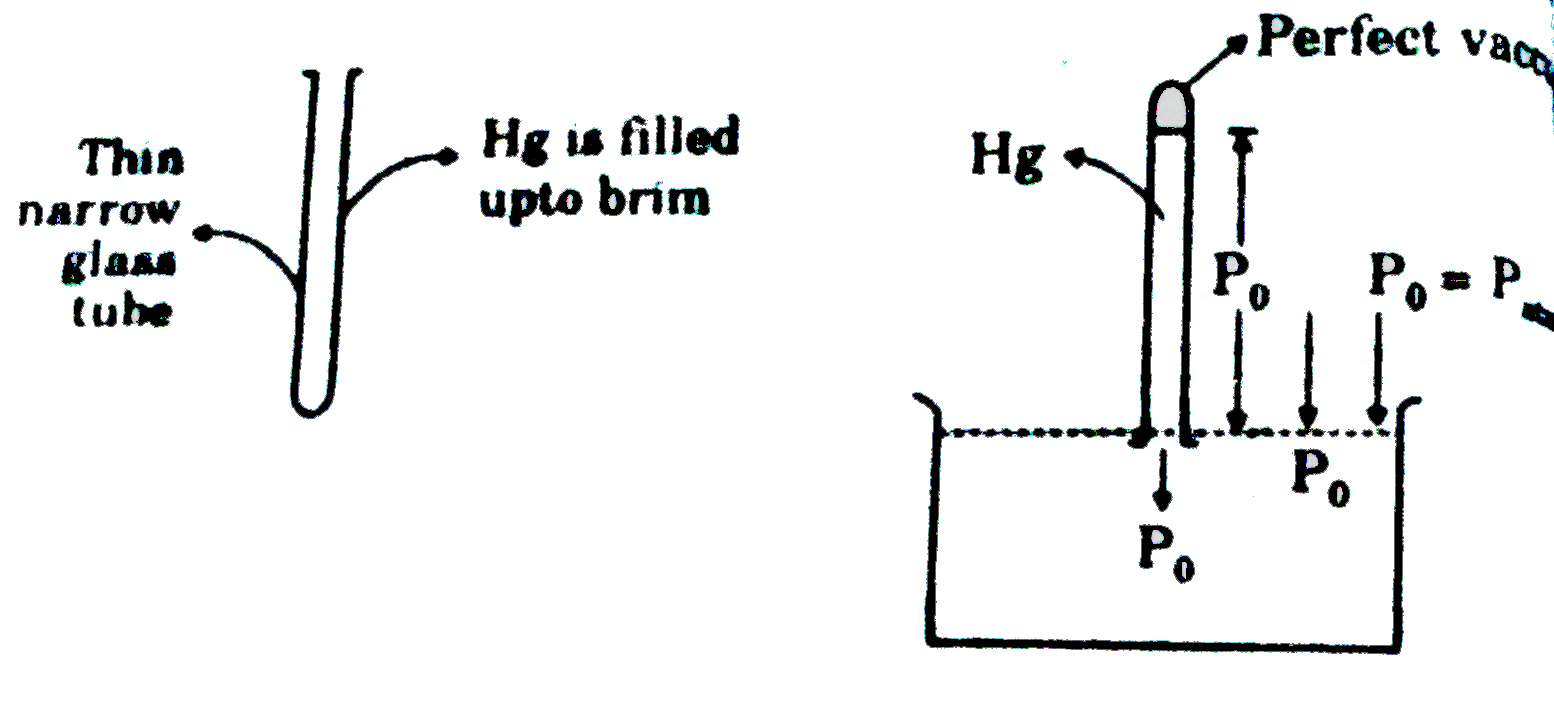
For such a faulty barometer
P0A=mg+PgasA
P0=ρhg+Pgas
or ρgh=P0−Pgas
A tube closed at one end is dipped in mercury as shown in figure such that the closed surface coincides with the mercury level in the container By how much length of the tube should be extended such that the level of Hg in the tube is 5 cm below the mercury level inside the container? (Assume temperature remains constant)
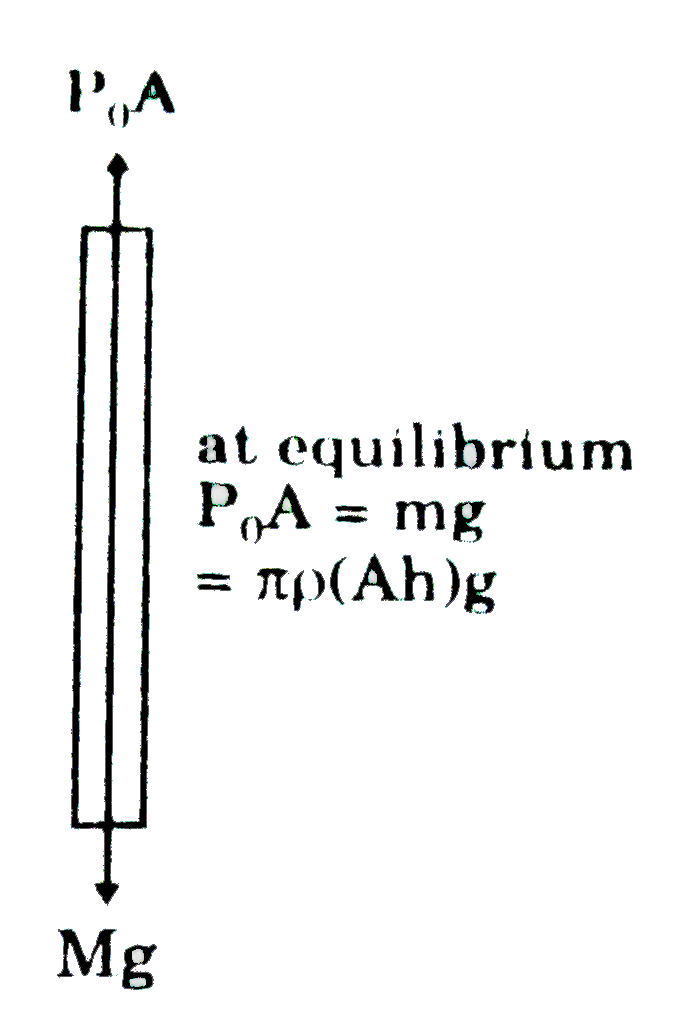
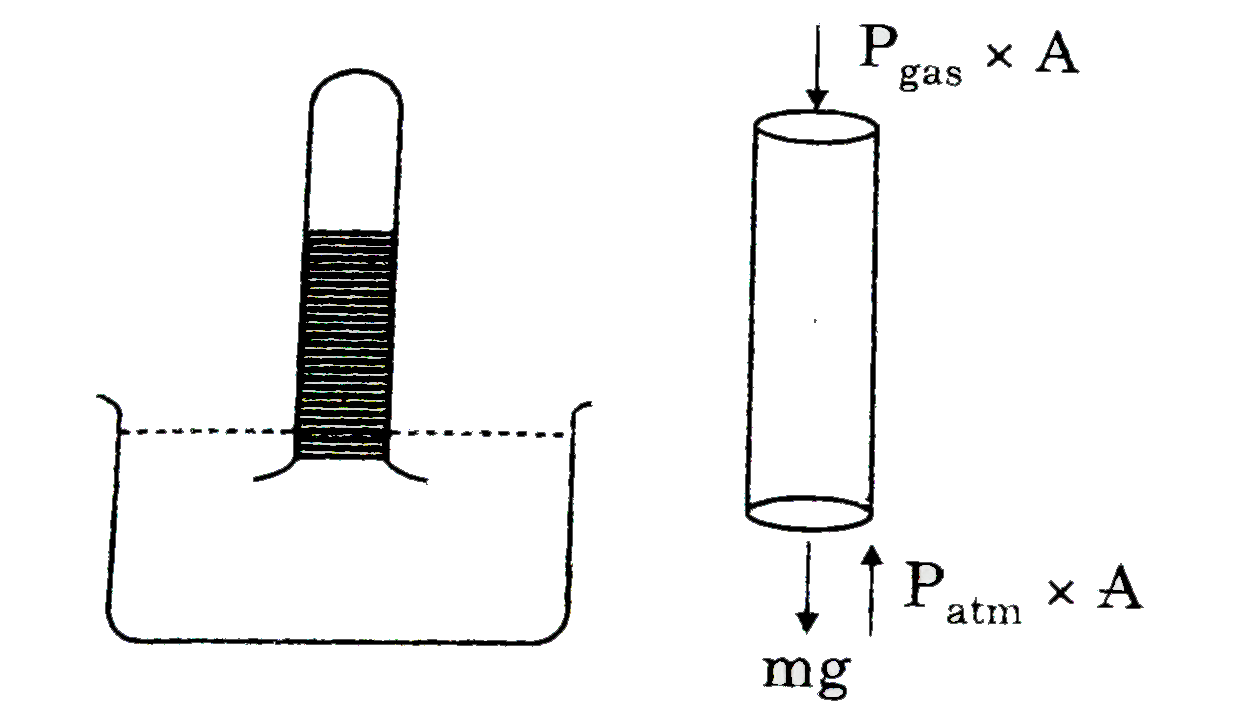
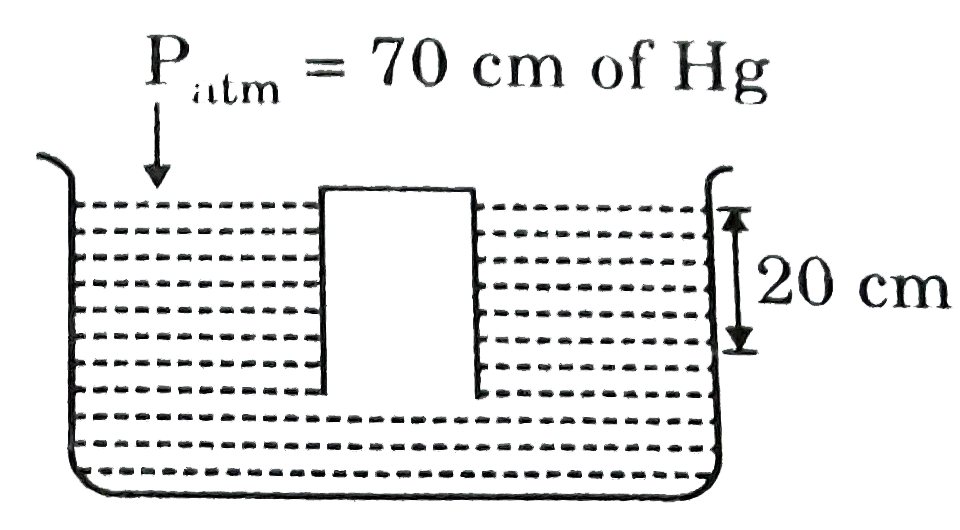 A18 cmB19 cmC24 cmD30 cm
A18 cmB19 cmC24 cmD30 cmAttempt any 4 sub-parts out of 5. Each sub-part carries 1 mark.
Read the following text and answer the following questions on the basis of the same:
Roget's spiral:
Magnetic effects are generally smaller than electric effects. As a consequence, the force between currents is rather small, because of the smallness of the factor μ. Hence, it is difficult to demonstrate attraction or repulsion between currents. Thus, for 5 A current in each wire at a currents. Thus, for 5 A current in each wire at separation of 1 cm, the force per metre would be 5×10−4N, which is about 50 mg weight. It would be like pulling a wire by a string going over a pulley to which a 50 mg weight is attached. The displacement of the wire would be quite unnoticeable. With the use of a soft spring, we can increase the using mercury, we can make the displacement of even a few mm observable very dramatically. You will also need a constant-current supply giving a constant current of about 5 A. Take a soft spring whose natural period of oscillations is about 0.5-1s. Hang it vertically and attach a pointing tip to its lower end, as shown in the figure here. Take some mercury in a dish and adjust the spring such that the tip is just above the mercury surface. Take the DC current source, sonnect one of its terminals to the upper end of the spring and dip the other terminal in mercury. If the tip of the spring touches mercury, the circuit is completed through mercury. Let the DC source be put off to begin with. Let the tip be adjusted so that it just touches the mercury surface. Switch on the constant current supply and watch the fascinating outcome. The spring shrinks with a jerk, the tip comes out of mercury (just by a mm or so), the circuit is broken, the current stop, the spring relaxes and tries to comes back to its original position, the tip again touches mercury establishing a current in the circuit and the cycle continues with tick, tick, tick, ....
What are main 3 components in a Roget's spiral?
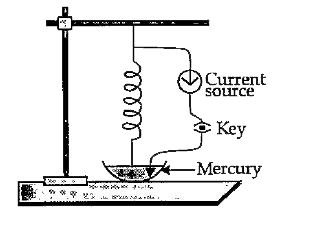 AMarcury, AC voltage sourceBMercury, DC voltage sourceCMercury, DC voltage source, keyDMercury, AC voltage source, key
AMarcury, AC voltage sourceBMercury, DC voltage sourceCMercury, DC voltage source, keyDMercury, AC voltage source, keyAttempt any 4 sub-parts out of 5. Each sub-part carries 1 mark.
Read the following text and answer the following questions on the basis of the same:
Roget's spiral:
Magnetic effects are generally smaller than electric effects. As a consequence, the force between currents is rather small, because of the smallness of the factor μ. Hence, it is difficult to demonstrate attraction or repulsion between currents. Thus, for 5 A current in each wire at a currents. Thus, for 5 A current in each wire at separation of 1 cm, the force per metre would be 5×10−4N, which is about 50 mg weight. It would be like pulling a wire by a string going over a pulley to which a 50 mg weight is attached. The displacement of the wire would be quite unnoticeable. With the use of a soft spring, we can increase the using mercury, we can make the displacement of even a few mm observable very dramatically. You will also need a constant-current supply giving a constant current of about 5 A. Take a soft spring whose natural period of oscillations is about 0.5-1s. Hang it vertically and attach a pointing tip to its lower end, as shown in the figure here. Take some mercury in a dish and adjust the spring such that the tip is just above the mercury surface. Take the DC current source, sonnect one of its terminals to the upper end of the spring and dip the other terminal in mercury. If the tip of the spring touches mercury, the circuit is completed through mercury. Let the DC source be put off to begin with. Let the tip be adjusted so that it just touches the mercury surface. Switch on the constant current supply and watch the fascinating outcome. The spring shrinks with a jerk, the tip comes out of mercury (just by a mm or so), the circuit is broken, the current stop, the spring relaxes and tries to comes back to its original position, the tip again touches mercury establishing a current in the circuit and the cycle continues with tick, tick, tick, ....
The force 10−3 N, is equivalent to:
 A100 mgB100 gC10 gD10 mg
A100 mgB100 gC10 gD10 mg
Read the passages given below and answer the questions that follow them:
1. Nowadays, Mother's Day celebrations are held throughout the world though they may not fall at the same time. The way of celebrating may also differ but the purpose is the same. It is to honour the mother and to feel and cherish the beautiful bonds we share with her. It would be interesting to find out how the idea of Mother's Day first took root and who was its originator.
2. The first celebrations were held in spring in ancient Greece, by paying tribute to Rhea, the ‘Mother of Gods’. During the 17th century, England honoured mothers by celebrating 'Mothering Sunday' on the fourth Sunday of Lent. In the United States, Julia Ward Home suggested the idea in 1872 and perceived Mother's Day as being dedicated to peace.
3. But it was Anna Jarvis of Philadelphia who brought about the official observance of Mother's Day. She wanted this day to be a holiday and launched a campaign for it. This she did in memory of her mother who died in 1905 and who had, in the late 19th century, tried to establish 'Mother's Friendship Days' as a way to heal the scars of Civil War.
4. In 1907, Jarvis held a ceremony in Grafton, West Virginia, to honour her mother. The proceedings touched her so greatly that she began a massive campaign to adopt a formal holiday for honouring mothers and in 1910, West Virginia became the first state to recognise Mother's Day. A year later, nearly every state officially marked the day. In 1914, President Woodrow Wilson officially proclaimed Mother's Day as a national holiday to be held on the second Sunday of May.
5. But all her efforts to make Mother's Day one of sentiment and love proved futile when she found that the holiday had been commercialised. Her accomplishment then turned bitter for her. She fought against the commercialisation of this day. She filed a lawsuit to stop a 1923 Mother's Day. She was even arrested for disturbing the peace at a War Mother's Convention where women sold white carnations. White carnation was her symbol for mothers, helping her to raise money. She never intended this day to be one for profit making and that was exactly what it had become.
6. Jarvis was never a mother herself. She spent her maternal fortune trying to stop the commercialisation of the holiday she founded. Today, countries like Denmark, Finland, Italy, Turkey, Australia and Belgium also celebrate Mother's Day on the same day as the United States.
On the basis of your reading of the passage, answer the question
How did Jarvis devote herself to the cause of Mother's Day celebrations?
View SolutionRead the passages given below and answer the questions that follow them:
1. Nowadays, Mother's Day celebrations are held throughout the world though they may not fall at the same time. The way of celebrating may also differ but the purpose is the same. It is to honour the mother and to feel and cherish the beautiful bonds we share with her. It would be interesting to find out how the idea of Mother's Day first took root and who was its originator.
2. The first celebrations were held in spring in ancient Greece, by paying tribute to Rhea, the ‘Mother of Gods’. During the 17th century, England honoured mothers by celebrating 'Mothering Sunday' on the fourth Sunday of Lent. In the United States, Julia Ward Home suggested the idea in 1872 and perceived Mother's Day as being dedicated to peace.
3. But it was Anna Jarvis of Philadelphia who brought about the official observance of Mother's Day. She wanted this day to be a holiday and launched a campaign for it. This she did in memory of her mother who died in 1905 and who had, in the late 19th century, tried to establish 'Mother's Friendship Days' as a way to heal the scars of Civil War.
4. In 1907, Jarvis held a ceremony in Grafton, West Virginia, to honour her mother. The proceedings touched her so greatly that she began a massive campaign to adopt a formal holiday for honouring mothers and in 1910, West Virginia became the first state to recognise Mother's Day. A year later, nearly every state officially marked the day. In 1914, President Woodrow Wilson officially proclaimed Mother's Day as a national holiday to be held on the second Sunday of May.
5. But all her efforts to make Mother's Day one of sentiment and love proved futile when she found that the holiday had been commercialised. Her accomplishment then turned bitter for her. She fought against the commercialisation of this day. She filed a lawsuit to stop a 1923 Mother's Day. She was even arrested for disturbing the peace at a War Mother's Convention where women sold white carnations. White carnation was her symbol for mothers, helping her to raise money. She never intended this day to be one for profit making and that was exactly what it had become.
6. Jarvis was never a mother herself. She spent her maternal fortune trying to stop the commercialisation of the holiday she founded. Today, countries like Denmark, Finland, Italy, Turkey, Australia and Belgium also celebrate Mother's Day on the same day as the United States.
On the basis of your reading of the passage, answer the question
Why did Jarvis's efforts to make Mother's Day as the day of sentiment and love prove futile?
View SolutionAccording to a new American study headed by Dr. Willis, it has been found that people who exercise in the morning seem to lose more weight than people completing the same workouts later in the day. These findings help shed light on the vexing issue of why some people shed considerable weight with exercise and others almost none. The study adds to the growing body of science suggesting that the timing of various activities, including exercise, could affect how those activities affect us. The relationship between exercise and body weight is somewhat befuddling. Multiple past studies show that a majority of people who take up exercise to lose weight drop fewer pounds than would be expected, given how many calories they are burning during their workouts. Some gain weight. But a few respond quite well, shedding pound after pound with the same exercise regimen that prompts others to add inches. The Midwest Trial 2, was conducted in the University of Kansas, U.S. on how regular, supervised exercise influences body weight. The trial involved 100 overweight, previously inactive young men and women who were made to work out five times a week at a physiology lab, jogging or otherwise sweating until they had burned up to 600 calories per session. After 10 months of this regimen, almost everyone had dropped pounds. But the extent of their losses fluctuated wildly, even though everyone was doing the same, supervised workout. A team of researchers started brainstorming what could be responsible for the enormous variability in the weight loss. They hit upon activity timing. They decided to do a Follow-up study of the MidWest Trial 2. In this new study, the MidWest Trial 2 Follow up study the researchers now studied a team of participants who could visit the gym whenever they wished between 7 a.m. and 7 p.m. They also tracked everyone's calorie intakes and daily movement habits throughout the 10 months. They knew, too, whether and by how much people's weights had changed. Now, they checked weight change against exercise schedules and quickly noticed a consistent pattern. Those people who usually worked out before noon had lost more weight, on average, than the men and women who typically exercised after 3 p.m. The researchers uncovered a few other, possibly relevant differences between the morning and late-day exercisers. The early-exercise group tended to be slightly more active throughout the day, taking more steps in total than those who worked out later. They also ate less. These factors may cumulatively have contributed to the striking differences in how many pounds people lost, Dr. Willis says. Thus it seems that people who worked out before noon lost more weight, on average, than those who typically exercised after 3 p.m. But Dr. Willis also points out that most of those who worked out later in the day did lose weight, even if not as much as the larkish exercisers, and almost certainly became healthier. "I would not want anyone to think that it's not worth exercising if you can't do it first thing in the morning," he says. "Any exercise, at any time of day, is going to be better than none."
Find one word which means the same as the following. a set of rules about food and diet that someone follows
View SolutionAccording to a new American study headed by Dr. Willis, it has been found that people who exercise in the morning seem to lose more weight than people completing the same workouts later in the day. These findings help shed light on the vexing issue of why some people shed considerable weight with exercise and others almost none. The study adds to the growing body of science suggesting that the timing of various activities, including exercise, could affect how those activities affect us. The relationship between exercise and body weight is somewhat befuddling. Multiple past studies show that a majority of people who take up exercise to lose weight drop fewer pounds than would be expected, given how many calories they are burning during their workouts. Some gain weight. But a few respond quite well, shedding pound after pound with the same exercise regimen that prompts others to add inches. The Midwest Trial 2, was conducted in the University of Kansas, U.S. on how regular, supervised exercise influences body weight. The trial involved 100 overweight, previously inactive young men and women who were made to work out five times a week at a physiology lab, jogging or otherwise sweating until they had burned up to 600 calories per session. After 10 months of this regimen, almost everyone had dropped pounds. But the extent of their losses fluctuated wildly, even though everyone was doing the same, supervised workout. A team of researchers started brainstorming what could be responsible for the enormous variability in the weight loss. They hit upon activity timing. They decided to do a Follow-up study of the MidWest Trial 2. In this new study, the MidWest Trial 2 Follow up study the researchers now studied a team of participants who could visit the gym whenever they wished between 7 a.m. and 7 p.m. They also tracked everyone's calorie intakes and daily movement habits throughout the 10 months. They knew, too, whether and by how much people's weights had changed. Now, they checked weight change against exercise schedules and quickly noticed a consistent pattern. Those people who usually worked out before noon had lost more weight, on average, than the men and women who typically exercised after 3 p.m. The researchers uncovered a few other, possibly relevant differences between the morning and late-day exercisers. The early-exercise group tended to be slightly more active throughout the day, taking more steps in total than those who worked out later. They also ate less. These factors may cumulatively have contributed to the striking differences in how many pounds people lost, Dr. Willis says. Thus it seems that people who worked out before noon lost more weight, on average, than those who typically exercised after 3 p.m. But Dr. Willis also points out that most of those who worked out later in the day did lose weight, even if not as much as the larkish exercisers, and almost certainly became healthier. "I would not want anyone to think that it's not worth exercising if you can't do it first thing in the morning," he says. "Any exercise, at any time of day, is going to be better than none."
The Mid West Trail 2 was a
View SolutionAccording to a new American study headed by Dr. Willis, it has been found that people who exercise in the morning seem to lose more weight than people completing the same workouts later in the day. These findings help shed light on the vexing issue of why some people shed considerable weight with exercise and others almost none. The study adds to the growing body of science suggesting that the timing of various activities, including exercise, could affect how those activities affect us. The relationship between exercise and body weight is somewhat befuddling. Multiple past studies show that a majority of people who take up exercise to lose weight drop fewer pounds than would be expected, given how many calories they are burning during their workouts. Some gain weight. But a few respond quite well, shedding pound after pound with the same exercise regimen that prompts others to add inches. The Midwest Trial 2, was conducted in the University of Kansas, U.S. on how regular, supervised exercise influences body weight. The trial involved 100 overweight, previously inactive young men and women who were made to work out five times a week at a physiology lab, jogging or otherwise sweating until they had burned up to 600 calories per session. After 10 months of this regimen, almost everyone had dropped pounds. But the extent of their losses fluctuated wildly, even though everyone was doing the same, supervised workout. A team of researchers started brainstorming what could be responsible for the enormous variability in the weight loss. They hit upon activity timing. They decided to do a Follow-up study of the MidWest Trial 2. In this new study, the MidWest Trial 2 Follow up study the researchers now studied a team of participants who could visit the gym whenever they wished between 7 a.m. and 7 p.m. They also tracked everyone's calorie intakes and daily movement habits throughout the 10 months. They knew, too, whether and by how much people's weights had changed. Now, they checked weight change against exercise schedules and quickly noticed a consistent pattern. Those people who usually worked out before noon had lost more weight, on average, than the men and women who typically exercised after 3 p.m. The researchers uncovered a few other, possibly relevant differences between the morning and late-day exercisers. The early-exercise group tended to be slightly more active throughout the day, taking more steps in total than those who worked out later. They also ate less. These factors may cumulatively have contributed to the striking differences in how many pounds people lost, Dr. Willis says. Thus it seems that people who worked out before noon lost more weight, on average, than those who typically exercised after 3 p.m. But Dr. Willis also points out that most of those who worked out later in the day did lose weight, even if not as much as the larkish exercisers, and almost certainly became healthier. "I would not want anyone to think that it's not worth exercising if you can't do it first thing in the morning," he says. "Any exercise, at any time of day, is going to be better than none."
What was the difference between the MidWest Trial 2 study and the MidWest Trial 2 Follow-up study that was taken up later?
View Solution

